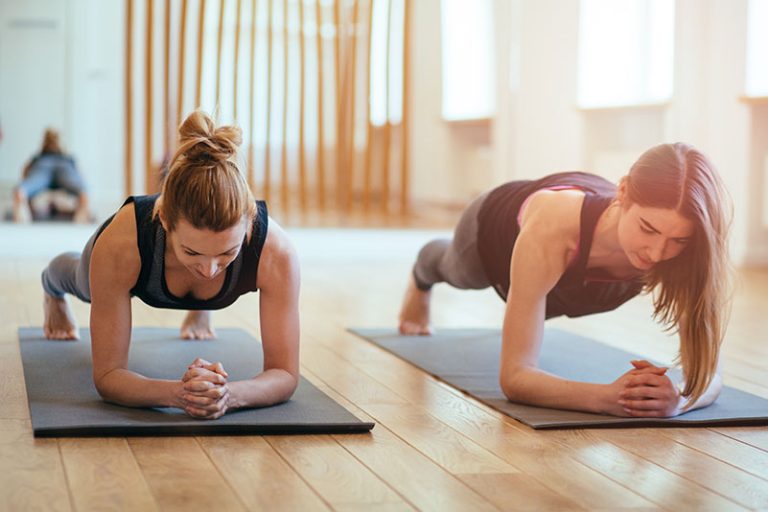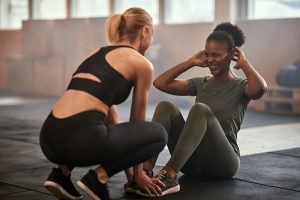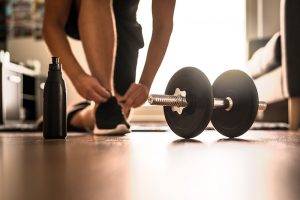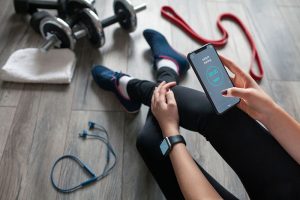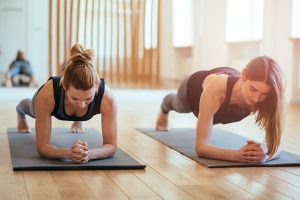When your body tells you to ease up or take a day off, listen to it. I’ve paid the price for not doing this.
If you haven’t read the story about my injuries click here and read the whole tale, it’s about a 4-minute read.
There are plenty of trainers who will tell you that pain is part of the journey to success. That’s true to some extent. Reaching your fitness goals involves going out of your comfort zone and pushing your limits. There are days it will feel like you can’t do one more push-up or one more minute on the treadmill. I’ve had more than a few clients curse me out during those moments!
But that pain shouldn’t carry over to the next day and it definitely shouldn’t happen at the start of a workout. That’s not a barrier to break through. That’s your body telling you to stop.
When I was a competitive bodybuilder, I pushed through pain when it wasn’t necessary. Instead of taking a few days off, minor aches became much larger problems over time. I now suffer from chronic back pain and will have to live with this for the rest of my life.
There’s good news though! If you have chronic pain or a permanent injury, you can still achieve your fitness goals. You just have to be smart about it.
Many of you have DM’d me on social media and asked what to do if a bad shoulder won’t allow you to lift weights or an injured knee can’t handle jumping jacks. The best solution? Low-impact workouts!
Just like the name implies, low-Impact workouts are low-weight bearing and typically exclude running or jumping. These workouts are also useful for people who are new to regular physical activity and need to ease their bodies in. Seniors, pregnant women, and those with arthritis should also lean toward low-impact activities.
But don’t let the name fool you! Low impact doesn’t mean low intensity. These workouts can be just as challenging as high-impact exercise and yield the same mental and physical benefits, all while being much easier on your joints.
“The key to physical activity is to choose an exercise that you enjoy and that you can incorporate into your personal schedule,” said Kathe Briggs, MS, a clinical exercise physiologist certified by the American College of Sports Medicine. “Everybody’s different. Some people work. Some people don’t work. Some people have small children. Some people have older adults that they’re taking care of. We’re all at a different places in life… [But] the research shows that as little as 10 minutes a day will get you some benefit.”
Check out eight of my favorite low-impact workouts that are guaranteed to make you sweat. Try one out this week and let me know what you think!
Swimming
Swimming is beneficial to your health and well-being at any age. One of my favorite things to do with the family is jumping in the river outside of our house during the summer. No one will be comparing me to Michael Phelps, but it’s a great activity that we can all do together.
A 2017 study found that swimmers typically live longer and that regular trips to the pool provide mental and physical boosts for seniors. Children also reap the rewards of this activity by developing social, cognitive, and physical skills quicker than those who don’t take lessons.
“For too long, national guidelines have concentrated on the cardiovascular benefits of exercise undertaken by healthy people, rather than on those who are less fit or have long-term health conditions,” said Mike Farrar, Swim England Group Board Chairman. “This report shows that activities like swimming really do have the potential to be a game-changer in supporting health, especially at a time when cuts to services mean less money for long-term care.”
The amount of calories burned by swimming is significant but depends on your level of exertion and current body size. Treading water at a moderate pace typically burns 220 calories per hour, while a butterfly stroke burns 880 calories per hour.
Not only does swimming burn fat, but it also builds muscle and overall strength, particularly in your arms, legs, core, and upper back. Need proof? Look at how ripped every Olympic swimmer is!
Rowing
Rowing is a textbook example of a total body workout. It works over 80 percent of your muscles including calves, core, arms, shoulders, and upper back. Of course, your legs are doing 60 percent of the work and most of the benefit will be seen in your lower body.
A 2015 study, published in the journal Annals of Rehabilitative Medicine, found significant benefits for participants who completed a six-week rowing program with sessions five days per week. Not only did they show drastic decreases in body fat percentage, but they also increased their back strength and lowered overall cholesterol levels.
Thirty minutes of moderate rowing will burn an average of 250 calories per hour, while 30 minutes of vigorous rowing burns an average of 300 calories per hour. Most people do interval training, which involves one minute of vigorous rowing followed by one minute of moderate rowing.
A 2012 research project from Waseda University in Japan also highlighted the benefit of rowing for seniors. The researchers noted its low impact on the knee joints and cited benefits including “improved aerobic capacity, increased skeletal muscle size, and prevention of atherosclerosis and vascular dysfunction.”
TRX
You’ve likely seen TRX straps at a gym before. It’s resistance training with your body weight that activates the torso and core muscles. I get bored doing the same routine for weeks on end, so TRX is perfect for me there are dozens of different exercises that can be performed with it.
A study from the American Council on Exercise found that cardiovascular endurance and body fat composition were improved when the TRX was added to a 60-minute workout for three days per week. The increased core muscle activation from this workout can even lead to slight improvements in balance.
A one-hour TRX session will typically burn anywhere from 360 to 530 calories. Because resistance training supports muscle growth, and muscle burns more calories than fat, TRX will also aid in weight loss by helping reduce overall body fat.
Yoga
Yoga studios are like Starbucks in Oregon – There’s one on every block now! From relaxation techniques to classes that will leave you drenched in sweat ,there’s a type of yoga to suit anyone’s taste. The health benefits have been helping people for literally thousands of years.
Findings from the International Journal of Yoga looked at the impact of doing yoga on 26 college-aged athletes, as well as separate studies with older adults and elderly patients. All three of these research projects found that practicing yoga for just 15-30 minutes per day can yield great improvements in flexibility, balance, and mobility.
Ever seen an advanced yogi put their leg behind their head? Some of the advanced poses require incredible flexibility and strength that would put my bodybuilding buddies to shame! But you don’t need to be at an advanced level to pick up the benefits of yoga.
Findings published in the Asian Journal of Sports Medicine followed adults who completed 24 cycles of sun salutations for six days per week over a six-month period. At the end of this time, the participants recorded significant increases in upper body strength, weight loss, and endurance.
Several studies in the National Institutes of Health database also show that practicing yoga could help reduce many types of chronic pain. One of these research papers, published in the Journal of Alternative and Complementary Medicine, showed how it benefits those with osteoarthritis in the knees by reducing pain and increasing strength.
But the benefits aren’t just physical. Numerous academic findings show that yoga may have anti-depressive effects that could reduce symptoms of depression, stress, and anxiety. Reducing these symptoms lowers the secretion of cortisol, the primary stress hormone, and ultimately contributes to better sleep quality.
The amount of calories burned per hour in a yoga session depends on the type you practice. Hatha yoga per hour, which is the standard general practice of yoga, will burn an average of 175-300 calories. Vinyasa and Ashtanga yoga, a more strenuous practice that coordinates movement to breathe, will knock off an average of 550 calories per hour.
Bikram yoga, also known as “hot yoga,” takes you through a series of poses and burns 330 calories per 90-minute session. But while hot yoga is all the rage these days, research has shown that the hot temperature alone does not help you burn extra calories.
Pilates
Similar to yoga, the goal of pilates is to strengthen muscles while improving flexibility and overall alignment. Each movement is slow, and deliberate and focuses on breath control. The primary focus of the exercises is on your core, but other areas including your back, hips, and thighs are also targeted.
Most pilates classes you’ll see fall into two categories; mat and reformer. Mat classes cushion pressure points on a mat that is slightly thicker than you’d use for yoga, while reformer classes use a sliding platform with pulleys, springs, and a stationary foot bar. You can’t go wrong with either one.
The number of calories burned in Pilates is typically between 125-300 calories per hour. Advanced classes will use harder exercises that require more effort and lead to more calories being burned.
Walking
Who said you need fancy equipment to get in shape? My finance and I have made walking around the neighborhood a regular part of our week. It’s a great way to get outside, do something together, and get in a little cardio.
Harvard Health reports that walking just 5.5 miles per week can reduce the risks of cardiovascular events like a heart attack or stroke by 32%. Walking also helps protect against other cardiac risk factors such as obesity, diabetes, high cholesterol, and high blood pressure. There are even mental benefits such as reducing depression symptoms and protecting against dementia.
Walking can also help protect you during cold and flu season, which is more important than ever because contracting COVID-19 and the flu simultaneously could have deadly consequences. Harvard Medical School found that people who walk for at least 20 minutes per day, five days per week, experienced 43% fewer sick days than those who exercised once a week or not at all. The illnesses they did get also exhibited milder symptoms and lasted for shorter durations.
Walking at a casual pace of 20 minutes per mile will cut about 100 calories per hour. Move to a more brisk pace of 12 minutes per mile and you’ll burn 130 calories per hour.
Perhaps the best part is that it can be done solo or with a friend. Having company on a daily stroll can make it more enjoyable and likely you’ll stick with it.
Hiking
Oregon is arguably the hiking hotspot of the United States. From the coastal beauty of Cape Falcon to the scenic views at the top of Fuji Mountain, I can guarantee that there’s a hike for you.
Hiking is a great way to improve your cardiovascular fitness while exploring the great outdoors. But unlike walking on a flat road or jogging on a treadmill, the slightly uneven surfaces on many trails also engage your core and can help improve balance skills.
Being in nature also has restorative powers that can aid in lowering stress relief. Stress often contributes to heart disease risk, high blood pressure, poor sleep quality, and symptoms of anxiety, so anything you can do to lessen this is a plus. Daniel Levitin, the author of Successful Aging, also notes that hiking helps your mind stay sharp.
A 2018 study from the journal Frontiers In Psychology found that walking in green spaces can help people recover from attention overload, which is the mental fatigue from being constantly distracted by technology. I’m not proud of it, but I’m always on my phone scheduling appointments, talking with clients, or responding to e-mails. Putting my phone on airplane mode for a few hours and enjoying the great outdoors is a necessity for me sometimes.
Hiking can cut as many as 550 calories per hour, but this depends on your pace, the difficulty of the terrain, and the weight of your hiking pack.
Indoor Cycling
Alright full disclosure; my favorite is outdoor cycling but this is about you, not me.
My clients who know me and follow my Strava know I love to ride. I know that cars and other dangers aren’t for everyone and cycling is not a cheap sport.
Indoor cycling is a great alternative.
You should know before picking a class that indoor cycling and spinning are not the same things. Spin classes look to simulate road cycling and focus solely on your leg muscles. Indoor cycling classes often incorporate hand weights or push-ups on the handlebars. You may also ride along to the beat of the music during an indoor cycling class.
But regardless of whether you prefer indoor cycling or spinning, you’ll get the same cardiovascular and stress-relieving benefits of walking or hiking. It also increases the endurance of your leg muscles including the calves, hamstrings, and quadriceps. Regular cycling will improve overall leg strength by strengthening the surrounding tendons, bones, and ligaments.
The American Council on Exercise lists indoor cycling as burning 350-600 calories per hour, depending on current body weight and level of intensity. It’s the caloric equivalent of running for an hour but with less impact on your body.
Talk with Your Doctor
TTP Training always recommends speaking with your doctor or medical practitioner before beginning a new exercise program. They can work with you to select appropriate activities based on your current level of fitness and any existing medical conditions.

